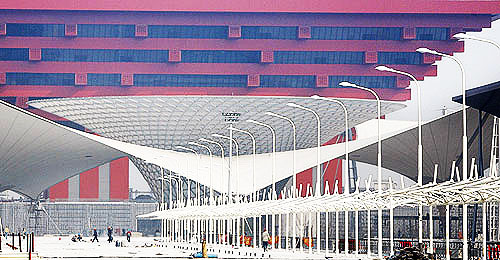|
 |
|
Green Light: Energy-saving LED (light-emitting diode) road lights have been installed along the 2010 Shanghai World Expo park's main road (PEI XIN) |
The UN Climate Change Conference concluded on the afternoon of December 19 in Copenhagen, Denmark. The scale of the meeting and the attention it has attracted speak to its great importance.
After strenuous negotiations, the Confe-rence of the Parties to the UN Framework Convention on Climate Change (UNFCCC) and the Meeting of the Parties to the Kyoto Protocol passed documents, decided to continue negotiations along the Bali Roadmap and commissioned the two working groups of the UNFCCC and the Kyoto Protocol to produce an outcome by the end of 2010.
The Copenhagen Accord, released at the Copenhagen Climate Change Conference, is a significant step taken by the international community to address climate change. The Accord has the following characteristics:
First, it upholds the principle of "common but differentiated responsibilities" and the dual-track negotiation mechanism under the UNFCCC and the Kyoto Protocol, as well as the mandate of the Bali Roadmap.
Second, the Accord seeks to engage as many countries as possible to cooperate in tackling climate change under the "common but differentiated responsibilities" principle. The Accord takes a step forward with regards to mandatory emissions cuts by developed countries and voluntary mitigation actions by developing nations.
Annex I Parties that are Party to the Kyoto Protocol will further strengthen emissions reductions while Annex I Parties that are not Party to the Kyoto Protocol, such as the United States, will commit to emission reduction targets for 2020. Delivery of reductions and financing by developed countries will be measured, reported and verified in accordance with relevant guidelines.
Non-Annex I Parties to the convention, namely the developing countries, will implement mitigation actions under the framework of sustainable development. Least-developed countries and small-island developing states may undertake actions voluntarily and on the basis of support.
Third, positive progress has been made in urging developed countries to provide financial and technological support. Developed countries are required to provide "new, additional, predictable and adequate funding to enable and support enhanced action on mitigation, including substantial financing to reduce emissions from deforestation and forest degradation, adaptation, technology development and transfer and capacity-building, for enhanced implementation of the convention."
Developed countries are required to collectively commit new and additional funding totaling $30 billion for the period of 2010-12.
In the context of meaningful mitigation actions and transparency in implementation, developed countries will commit to a goal of jointly mobilizing $100 billion a year by 2020 to address the needs of developing countries in combating climate change.
New multilateral funding with equal representation of developed and developing countries will be set up. Countries most vulnerable to climate change will have priority in receiving funding for adaptation. Although the financial commitment of developed nations still falls short of the funding needed by developing countries to address climate change, it is nonetheless a quantified and predictable target.
To enhance actions on development and technology transfer, the Accord established a Technology Mechanism to support adaptation and mitigation. This will provide an institutional guarantee to advance the mass application of climate-friendly technologies.
Fourth, the Accord upholds the interests of developing countries regarding the measurement, reporting and verification of mitigation actions. As developing countries are Non-Annex I Parties, only their supported nationally appropriate mitigation actions will be subject to international measurement, reporting and verification in accordance with guidelines adopted by the Conference of the Parties, whereas their voluntary mitigation actions will be subject to domestic measurement, reporting and verification. Information on the implementation of their actions will be communicated through National Communications once every two years, with provisions for international consultations and analysis under clearly defined guidelines that will ensure that national sovereignty is respected.
Fifth, the Accord also sets a long-term target of limiting the increase in the global average temperature to 2 degrees Celsius over pre-industrial times. To ensure long-term goals and that the corresponding adaptation and mitigation actions be backed by the newest scientific research, a comprehensive assessment on the implementation of the Copenhagen Accord, as well as the long-term goals, shall consider the release date of the UN Intergovernmental Panel on Climate Change Fifth Assessment Report.
Combating climate change is an arduous task. This meeting was not a destination, but a new start. The UNFCCC and its Kyoto Protocol are the outcomes of long and hard work by all countries. They reflect the broad consensus among all parties and serve as the legal basis and guide for international cooperation on climate change.
The principles enshrined in the convention, the protocol and the mandate of the Bali Roadmap must be followed. Countries should honor their promises, fulfill their obligations and make unremitting efforts.
Developed countries must take the lead in making deep quantifiable emissions cuts and providing financial and technological support to developing countries. This is a moral responsibility that they cannot shirk as well as a legal obligation that they must fulfill. Developing countries should, with the financial and technological support of developed countries, do what they can to mitigate greenhouse gas emissions and adapt to climate change in light of their national conditions.
The author is head of the China Meteorological Administration | 